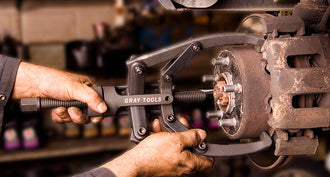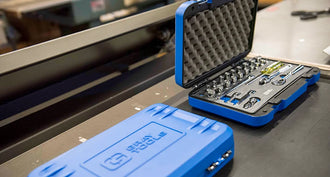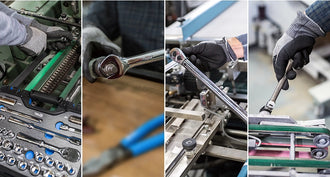How to Choose and Maintain Your Next Ratchet
- Gray Tools Official Blog
- 02 Dec, 2015

Ratchets are one of the mechanic’s most used tools. In today's market you will find in a variety of lengths and designs all created to help complete repairs quickly and efficiently. If you are wondering what to look for in your next ratchet, read on.
Choosing Your Next Ratchet: 3 Things to Consider
Ratchets are available in different sizes and shapes such as slim head, flex head, go-through head, just to name a few. The two most common designs are the pear-shaped (or teardrop) and round head. Choosing one design over the other is a matter of personal preference, as either will deliver years of reliable service. Ratchets come in an array of drive sizes, the most popular being ¼", ⅜", and ½".
Before buying your next ratchet, it is important to consider what the likely applications will be. Once determined, establish whether you need a long reach ratchet, stubby ratchet, or flex-head ratchet for getting into tight areas such as on the newer, smaller, compact automobiles.
A second consideration is the number of teeth. The larger the tooth count the smaller the arc required to turn the ratchet. This is ideal when removing fasteners in confined spaces. The trade-off is these types of ratchets generally have lower maximum torque output. Therefore, if high torque is the primary need choose a ratchet with fewer teeth. If fine-tuning and confined space work is the priority, choose a model with 72 or more teeth. Choosing the right model is key to prevent damaging the ratchet or causing personal injury.
A third consideration is the quality and material used in the ratchet. With today’s advances in metallurgy, forging, machining and heat treatment ratchets are available in a variety of materials. Examples include S2 steel, carbon steel, lightweight composite or titanium, non-sparking metal alloys and even insulated for working in precision of live electricity.
Other features to consider include:
• Handle shape and size. Do you prefer an all steel or comfort grip? All steel is most durable but can be slippery in some applications. Multi-material grip handles may help reduce slippage, however are less durable in the presence of oils and solvents
• Release mechanism. Do you need a quick release button? A quick release button is the easiest way to remove sockets and attachments especially when hands are slippery or greasy. The downside is quick release design ratchets will allow more damaging dirt and debris to enter ratcheting mechanism compared to a full closed back model.
Ratchet Maintenance Tips
Proper maintenance and serviceability are key to getting the most out of your new ratchet. A quality hand tool brand will have spare parts and be willing to service a ratchet years, even decades after initial purchase. Additionally, quality brands will back their ratchets will a lifetime warranty.The ratchet is likely the most neglected tool in any toolbox. It is put to the test daily, but seldom taken apart to be cleaned and lubricated. Below are some tips on maintaining your next ratchet for years of reliable service.
1. Take it apart as soon as you sense a problem or do not hear a smooth clean ratcheting sound. On pear-shaped models, you will usually find two screws or a snap ring holding in place a back plate.
2. Inspect the gear and pawl to see if they are in good condition. 95% of damaged ratchets have been over torqued causing the gears to strip but not break. You will notice this as a shearing of the gears; otherwise, you will find pieces of the ratchets in the head.
3. Once the head has been removed take out the gear and clean it thoroughly with a degreasing product. Spray the head with the degreaser and switch the reverse lever back and forth to remove the dirt from between the pawl and the housing.
4. When all the dirt has been removed replace the gear and lubricate with good oil, NOT WD40 or other degreasing product. These products clean but to do lubricate properly. Do not use grease, as it will attract dirt that builds up and turns into a grinding compound, wearing the ratchet out prematurely. Simply use a little oil.
5. Replace the back plate and you will find the ratchet back to new condition.
6. With the round head ratchets, there is a ring on the moveable ratchet mechanism that must be removed. Inspect the gears that are part of the main ratchet head. Clean all debris from the gears with a cleaning brush and solvent. Inspect the moveable gear (pawl). It has a pawl mechanism built into the moveable part. Clean it and inspect the teeth making sure the teeth are not damaged. Follow the same steps as above lubricating the ratchet.
7. To ensure maximum performance and reliability preform the above maintenance steps at least once per year.
When using any ratchet choose the right size. Don’t try to use a ⅜" drive ratchet to do the job of ½" model. That means using the largest ratchet whenever possible. Ratchets are essential to getting a job done quickly and properly.
In summary, carefully determine your needs before buying, implement an annual maintenance and inspection routine, and consider long-term serviceability. As the workhorse in a toolbox, consider your next ratchet purchase an investment. One that if chosen properly should last a lifetime. A cheaply priced ratchet may cost less upfront but could prove much more costly if fails and cannot be serviced, damages a work piece or worse causes personal injury.
Happy ratcheting.
David Weatherby has over 40 years of experience in the hand tool industry, representing premium brands such as Snap-on and Gray Tools. He has helped thousands of professionals build and maintain their tool collection for years of reliable use.




Thanks for phrase “that means using the largest ratchet wherever possible”. I get grief from buddies who mock my use of 3/4" and one inch ratchets to remove motorcycle wheel lug nuts, and other higher torqued bolts. Instead of throwing your weight onto a smaller ratchet, which rocks the vehicle, the weight of the larger tool does most of the work.